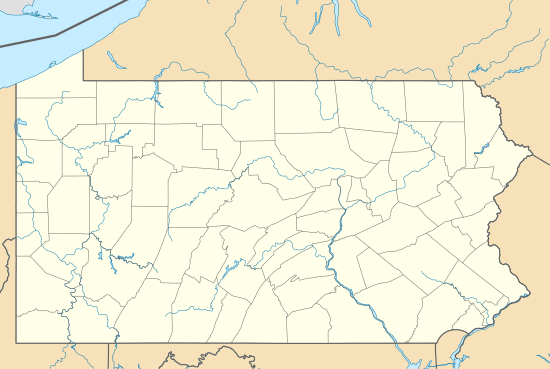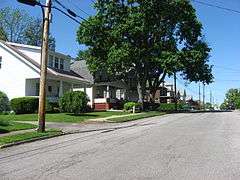North Hill Historic District (New Castle, Pennsylvania)
|
North Hill Historic District | |
|
Fairmont Avenue, North Hill Historic District | |
 | |
| Location | New Castle, Pennsylvania |
|---|---|
| Coordinates | 41°0′48″N 80°20′37″W / 41.01333°N 80.34361°WCoordinates: 41°0′48″N 80°20′37″W / 41.01333°N 80.34361°W |
| Area | 449.7 acres (182 ha) |
| Architectural style | 19th and 20th Century, Late Victorian, 19th Century Revival |
| NRHP Reference # | 00000056[1] |
| Added to NRHP | February 18, 2000 |
The North Hill Historic District is a residential neighborhood in the city of New Castle, Pennsylvania, that was entered into the National Register of Historic Places in 1999.[2] The 91-block district consists of roughly 450 acres (1.8 km2) of land that sit slightly north of New Castle's business district.[2] The area is historic due to the many ornate homes and mansions—many dating back to the 19th century—that lie within its boundaries.[3]
Architecture
The district includes a variety of architectural styles. Its 1,888[2] buildings include Late 19th and Early 20th Century, Late Victorian, and Late 19th and 20th Century Revivals.[2] One such residence was built in 1895 for Mathias Holstein Henderson, a prominent New Castle resident who at the time was vice-president of Lawrence Saving and Trust (now National City Bank).[3] The home is now maintained by the Meehan family. The Reis Home, formerly located at 318 East Street, was built for steel manufacturer William Reis.[3] The two-story Colonial Revival home remained in the Reis family until 1993 and was eventually demolished to make room for the new New Castle High School.[3] In addition to these and other historic buildings, a concrete girder bridge on Boyles avenue was reportedly built by the Works Progress Administration (WPA).[4] Also located in the district is the Scottish Rite Cathedral.
Most of the homes in the district are built of either masonry or wood and contain multiple floors.[2] Though the district consists primarily of single and multiple dwellings, there exists a very small percentage of commercial and health care properties. Four schools and four religious buildings also reside within the district.[2] The sidewalk patterns have remained unchanged since at least 1904. Queen Anne, Folk Victorian, Neoclassical, and Colonial Revival are the most common design styles of homes overlooking the downtown area.[2]
Significance
With urban residential growth in the historic district beginning in 1870 and ending in 1949, the National Register's 50-year guideline for significance is met.[2] The district is significant under National Register Criterion C for architecture, and Criterion A for industry; the neighborhood is where executives of local industries (steel, tin, and iron) lived.[2]
References
- ↑ "NPS Focus". National Register of Historic Places. National Park Service. Retrieved August 1, 2010.
- 1 2 3 4 5 6 7 8 9 Living Places
- 1 2 3 4 Lawrence County Historical Society
- ↑ George, Thomas J (October 7, 1999). "North Hill Historic District" (PDF). National Register of Historic Places Registration Form. Pennsylvania Historical and Museum Commission. Retrieved August 2, 2010.
External links
- North Hill Historic District
- Lawrence County Historical Society Walking Tour
- Lawrence County Industrial History


